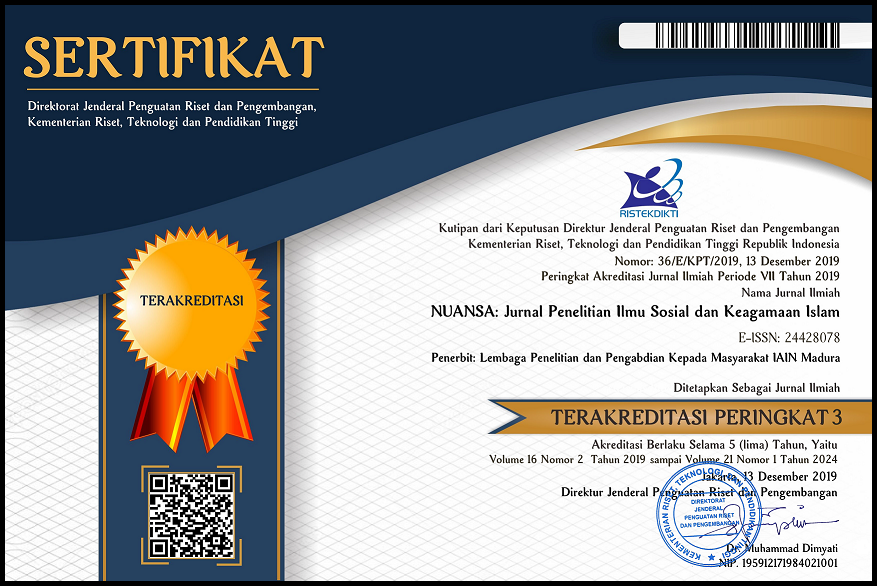Internalisasi Hadis Tarbawi dalam Media Sosial “Omar Hana” Sebagai Model Pendidikan Anak Islam di Indonesia
 Abstract views: 279
,
Abstract views: 279
,
 PDF downloads: 332
PDF downloads: 332
Abstract
The development of hadith studies continues to experience dynamism, not only sanad and matan, but has developed into various trends of study from text to social media. Various innovations and creations of hadith literature began to emerge, such as Omar Hana's Islamic animated content. This research focuses on the internalization of hadith in Omar Hana's Islamic animation content as a way of Islamic child education, with the formulation of problems that include the interpretation of hadith in Omar Hana's Islamic animation content, aesthetic value, and its positive implications. The goal is to reveal the form of hadith reception in Omar Hana's Islamic animation in internalizing the Prophet's hadith as Islamic child education. The method used in the research is library research with the theory of reception introduced by Ahmad Rafiq, which refers to three steps, namely exegesis, aesthetic, and functional. This study found the first fact, that the hadith in Omar Hana's Islamic animation content is conveyed with song lyrics accompanied by typical children's backsound and displays the hadith translation at the end of the video. Second, the reception of the hadith text in the content of Omar and Hana uses aesthetic reception of hadith in the form of digitally animated visualization. While the hadith used is themed on daily practices from waking up to sleeping again by taking pieces of the matan of the hadith without including the sanad and the quality of the hadith. Functionally, the value of the teaching can be a medium for children's moral education although it is not representative enough in terms of the scientific discourse of hadith by mentioning the position of the status of hadith.
Downloads
References
Ainy, Mahda Qurratu’, and Eka Cahya Maulidiyah. ‘Pengaruh Media Film Animasi Nussa Dan Rara Terhadap Sikap Sopan Santun Anak Usia 5-6 Tahun’. Paud Teratai 12, no. 2 (2023): 1–6. https://ejournal.unesa.ac.id/index.php/paud-teratai/article/view/54819.
Aizenkot, Dana. ‘A Quantitative and Qualitative Approach to Analysing Cyberbullying in Classmates’ WhatsApp Groups’. In Understanding Media and Society in the Age of Digitalisation, edited by Dennis Nguyen, Ivonne Dekker, and Sergul Nguyen. Switzerland: Palgrave Macmillan, 2020. https://doi.org/10.1007/978-3-030-38577-4.
Al-’Iraqi, Ibn Al-Subki, and Al-Zubaidi. Takhrij Ahadits Ihya` ’Ulum Al-Din. Riyadh: Dar al-’Ashimah, 1987.
Al-Baihaqi, Al-Hafizh Abi Bakr Ahmad bin al-Husain bin Ali. Al-Sunan Al-Kabir. Juz 1. Kairo, 2011.
Al-Baihaqi, Al-Imam al-Hafizh Abi Bakr Ahmad bin al-Husain. Al-Jami’ Li-Syu’ab Al-Iman. Juz 12. Maktabah al-Rusyd, 2003.
Al-Bukhari, Al-Imam Abi Abdillah Muhammad bin Ismail. Shahih Al-Bukhari. Beirut: Dar Ibn Katsir, 2002.
Al-Imam al-Hafizh Abi al-Husain Muslim bin al-Hajjaj al-Qusyairi al-Naisaburi. Shahih Muslim. Jilid 1. Riyadh: Dar Thaibah, 2006.
Al-Sijistani, Al-Imam al-Hafizh Abi Dawud Sulaiman bin al-Asy’ats. Sunan Abi Dawud. Juz 3. Beirut: Dar al-Kutub al-’Ilmiyah, 1996.
———. Sunan Abi Dawud. Juz 1. Beirut: Dar al-Kutub al-’Ilmiyah, 1996.
Al-Syaibani, Abdullah Ahmad bin Muhammad bin Hanbal bin Asad bin Idris bin Abdullah bin Hasan. Musnad Al-Imam Ahmad Bin Hanbal. Riyadh: Dar al-Salam, 2013.
Al-Tirmidzi, Al-Imam al-Hafizh Muhammad bin Isa bin Saurah. Sunan Al-Tirmidzi. Riyadh: Maktabah al-Ma’arif, n.d.
Alwi, Zulfahmi, Akbar, Amin Hady, Abdul Muiz Amir, Jawiah Dakir, and Latifah Abdul Majid. ‘The Anomaly of Good-Looking : The Relationship Between Spirituality and Extremism on Hadith and Social Religious Perspective’. Qijis: Qudus International Journal of Islamic Studies 9, no. 2 (2021): 463–502. https://doi.org/10.21043/qijis.v9i2.10476.
Bukhari, and Nufiar. ‘Peran Guru Akidah Akhlak Dalam Memilih Film Animasi Yang Islami Sebagai Sumber Belajar Siswa Di Masa Pasca Pandemi’. Azkia: Jurnal Aktualisasi Pendidikan Islam 18, no. 1 (2023): 1–11. http://journal.stitalhilalsigli.ac.id/index.php/azkia/article/view/324/272.
Gomes, Catherine, Lily Kong, and Orlando Woods. Religion, Hypermobility and Digital Media in Global Asia: Faith, Flows and Fellowship. Amsterdam: Amsterdam University Press, 2020. https://doi.org/10.5117/9789463728935.
Grieve, Gregory Price. ‘Religion’. In Digital Religion: Understanding Religious Practice in Digital Media, edited by Heidi A. Campbell and Ruth Tsuria, 2nd ed. New York: Routledge, 2022. https://doi.org/10.4324/9780429295683.
Hasanah, Latiphah, Azkiyatul Farichah, Indah Safitri, Nabila Arahma Wardani, and Nanda Putri ’Ainu Wardah. ‘Nilai Moral Dalam Film Kartun Animasi Omar Dan Hana’. Jurnal Ilmiah Pesona Paud 10, no. 1 (2023): 25–38. https://doi.org/10.24036/120309.
Khan, Ruqayya Yasmine, and Ashley Kyong Aytes. ‘Islam and New Media: Islam Has Entered the Chat’. In Religion in the Age of Digitalization: From New Media to Spiritual Machines, edited by Giulia Isetti, Elisa Innerhofer, Harald Pechlaner, and Michael de Rachewiltz. New York: Routledge, 2021.
Mardiah, Syarifah, and Munisa. ‘Pemahaman Dan Aplikasi Nilai-Nilai Adab Makan Dan Minum Melalui Animasi Kartun Islami Di RA El Syarifah Medan’. Journal on Education 6, no. 1 (2023): 9328–38. https://doi.org/10.31004/joe.v6i1.4452.
Melati, Inka Krisma, Hari Windu Asrini, and Ajang Budiman. ‘Karakter Islami Dalam Film Animasi Nussa Dan Rara Episode Cerita Rara: Kajian Sosiolinguistik’. Kode: Jurnal Bahasa 11, no. 3 (2022): 86–97. https://doi.org/10.24114/kjb.v11i3.38821.
Mufidah, Nastiti, and Maya Zahrotul Maulida. ‘Meningkatkan Kemampuan Ibadah Amaliyah Melalui Kegiatan Praktik’. Ma’alim: Jurnal Pendidikan Islam 3, no. 2 (2022): 201–9. https://doi.org/10.21154/maalim.v3i2.4475.
Mukaromah, Kholila. ‘Wacana Kesetaraan Gender Dalam Meme Hadis: Studi Etnografi Virtual Pada Akun Instagram @mubadalah.Id’. Mutawatir: Jurnal Keilmuan Tafsir Hadith 10, no. 2 (2020): 292–320. https://doi.org/10.15642/mutawatir.2020.10.2.292-320.
Muzakky, Althaf Husein, and Fahrudin. ‘Kontekstualisasi Hadis Dalam Interaksi Media Sosial Di Era Millenial Dalam Kitab Fath Al-Bari Syarah Hadis Al-Bukhari’. Diroyah : Jurnal Studi Ilmu Hadis 5, no. 1 (2020): 12–20. https://doi.org/10.15575/diroyah.v5i1.7515.
Nurmansyah, Ihsan. ‘Islam Dan Media Sosial: Kajian Living Hadis Dalam Film “Papi Dan Kacung” Di Instagram’. Fikri: Jurnal Kajian Agama, Sosial Dan Budaya 4, no. 2 (2019): 201–16. https://doi.org/10.25217/jf.v4i2.591.
———. ‘Resepsi Dan Transmisi Pengetahuan Dalam Film Papi Dan Kacung Episode 8-11 Sebuah Kajian Living Hadis’. Al-Quds: Jurnal Studi Alquran Dan Hadis 3, no. 2 (2019): 97–118. https://doi.org/10.29240/alquds.v3i2.1072.
Omar & Hana Indonesia. Adab Makan, Animasi Anak Islami, Omar & Hana Subtitle Indonesia. www.youtube.com, 2022. https://youtu.be/supXKUD2OMs?si=RF2BeKt9AgUJMJcr.
———. Bismillah, Lagu Anak Islami, Omar & Hana Subtitle Indonesia. www.youtube.com, 2021. https://youtu.be/TLo3w0Ew4NA?si=UMjoePj0vfrVhGnX.
———. Doa Setelah Wudhu, Animasi Anak Islami, Omar & Hana Subtitle Indonesia. www.youtube.com, 2022. https://youtu.be/j6om-HvDHaA?si=RbB5HasViP4s_Qj2.
———. Indahnya Sedekah, 30 Hari Ramadan, Omar & Hana Subtitle Indonesia. www.youtube.com, 2022. https://youtu.be/KBt6jEHG164?si=VbV9nWUInKFrgHTA.
———. Lagu Anak Islami, Omar & Hana Kompilasi 55 Menit. www.youtube.com, 2023. https://youtu.be/KcpmmvMiOI0?si=IVt3yDalXelns8nR.
———. Rezeki, Lagu Anak Islami, Omar & Hana Subtitle Indonesia. www.youtube.com, 2021. https://youtu.be/8Yh3MkP6Aqg?si=REdLnyuZq3MZG93G.
———. Sopan Santun, Animasi Anak Islami, Omar & Hana Subtitle Indonesia. www.youtube.com, 2022. https://youtu.be/zf5ElKJUnzA?si=hYJbyvV6Lpxr9rTF.
———. Terima Kasih, Lagu Anak Islami, Omar & Hana Subtitle Indonesia. www.youtube.com, 2022. https://youtu.be/AcvWjBf__ZE?si=_iWOifzFpJBSVuFA.
Rafiq, Ahmad. ‘The Reception of the Qur’an in Indonesia: A Case Study of the Place of the Qur’an in a Non-Arabic Speaking Community’. The Temple University Graduate Board, 2014.
Rony, and Siti Ainun Jariyah. ‘Urgensi Pendidikan Karakter Dalam Membentuk Akhlak Peserta Didik’. Tafkir: Interdiseiplinary Journal of Islamic Education 1, no. 1 (2020): 79–100. https://doi.org/10.31538/tijie.v1i1.18.
Saepudin, Miftahudin, and Hamdan. ‘Implementing Morals and Religious Education in Islamic Boarding Schools to Prevent Radicalism-Terrorism’. Madania: Jurnal Kajian Keislaman 26, no. 2 (2022): 139–52. https://doi.org/10.29300/madania.v26i2.7858.
Susnita, Samin, and Ravico. ‘Analisis Strategi Dakwah Dalam Film Animasi Islami Riko Teh Series Dan Pengaruhnya Terhadap Anak-Anak TPA Madrasah Diniyyah Awaliyah Fathul Amal Di Desa Baru Pulau Sangkar’. Journal of Da’wah 1, no. 1 (2022): 54–84. https://doi.org/0.32939/jd.v1i1.1292.
Utami, Silvia Putri, and Yudi Asmara Harianto. ‘Da’wa Critical Discourse Analysis in the Omar and Hana Cartoon Film on Alalala Raju Episode’. Komunika: Jurnal Dakwah Dan Komunikasi 15, no. 1 (2021): 55–69. https://doi.org/10.24090/komunika.v15i1.4493.
Wati, Nina Tisna. ‘Penggunaan Media Berbasis Audio-Visual Dalam Film Omar Dan Hana Sebagai Penanaman Akhlak Karimah Anak Usia Dini Di Paud Aisyiyah Tenjung Qencono’. Journal of Islamic Education for Early Chilhood 4, no. 1 (2022): 1–15. https://doi.org/10.30587/jieec.v4i1.3677.
Westri, Zola, and Rismareni Pransiska. ‘Analisis Nilai-Nilai Agama Dan Moral Anak Usia Dini Pada Film Animasi Omar Dan Hana’. Jurnal Golden Age 5, no. 1 (2021): 221–32. https://doi.org/10.29408/goldenage.v5i01.3497.
Copyright (c) 2024 NUANSA: Jurnal Penelitian Ilmu Sosial dan Keagamaan Islam

This work is licensed under a Creative Commons Attribution-NonCommercial 4.0 International License.
The journal operates an Open Access policy under a Creative Commons Attribution-NonCommercial 4.0 International License (CC-BY-NC) 
Authors who publish with this journal agree to the following terms:
- Authors retain copyright and grant the journal right of first publication with the work simultaneously licensed under a Creative Commons Attribution License that allows others to share the work with an acknowledgement of the work's authorship and initial publication in this journal.
- Authors are able to enter into separate, additional contractual arrangements for the non-exclusive distribution of the journal's published version of the work (e.g., post it to an institutional repository or publish it in a book), with an acknowledgement of its initial publication in this journal.
- Authors are permitted and encouraged to post their work online (e.g., in institutional repositories or on their website) prior to and during the submission process, as it can lead to productive exchanges, as well as earlier and greater citation of published work.





















